The Monday Ten Goes on Vacation
College basketball starts in earnest this week with a series of early-season holiday tournaments, where some Big Ten teams will face their staunchest tests so far this season. The destinations – Maui, NYC, Cancun, the Bahamas, Vegas – add an element of quirkiness that is singular to college basketball; fanbases from various corners of the country get to watch their teams play a few games in a unique environment over the span of a few days. It serves multiple purposes: teams get to go on vacation, often add quality opponents to their non-conference schedule, and practice quick turnarounds that they’ll later see in conference tournaments (and possibly the NCAA Tournament).
This week’s ten:
- First-round opponents
- Projecting second- and third-round opponents
- Five possible games I’d love to see
- James Blackmon, Jr. to the rescue
- Indiana wins a battle of extremes against SMU
- Tough opponents and expected losses
- Somebody rushes the court against Nebraska
- Penn State (barely) goes 2-1 in Charleston
- Chucker Watch
- Saluting Shannon Scott
* * *
1. First-round opponents
In an (admittedly arbitrary) order from most- to least-intriguing games. Rankings are via kenpom.com from late Sunday night.
- 17. Michigan vs. 30. Oregon (11-24, 9:30, ESPN3)
- 26. Maryland vs. 68. Arizona St. (11-24, 7:00, ESPNU)
- 38. Purdue vs. 55. Kansas St. (11-24, 2:30, ESPN2)
- 34. Minnesota vs. 47. St. John’s (11-26, 7:00, ESPNU)
- 40. Illinois vs. 144. Indiana St. (11-28, 5:00, FS1)
- 128. Rutgers vs. 86 Vanderbilt (11-28, 7:00, NBCSN)
- 101. Northwestern vs. 248 Miami (OH) (11-25, 9:30, CBSSN)
- 4. Wisconsin vs. 203. UAB (11-26, 7:00, AXS.tv)
- 14. Michigan St. vs. 198. Rider (11-28, 6:30, ESPN2)
Monday features some of the best early matchups, as Michigan, Maryland, and Purdue each face their first real tests of the season. The Boilermakers face former Illinois coach, Bruce Weber, and Kansas State to kick off the Maui invitational: the Wildcats are coming off of an upset loss at Long Beach State. Maryland draws Arizona St.; neither team has been seriously tested by weak schedules thus far and both teams are featuring plenty of new faces all over the court. Michigan plays the late game against Oregon – a team that’s replacing nearly everyone from last season.
2. Projecting second- and third-round opponents
By using Ken Pomeroy’s Pythagorean value for each of the teams in a log5 simulation, I found the probability that a given team would face a certain opponent in the second and third rounds of their tournaments.
3. Five possible games I’d love to see
- Michigan St. vs. Kansas – Even though this matchup would likely require both teams to win their first two games, there’s still a very good chance due to the overall weakness of the rest of the field (outside of perhaps Tennessee). Both teams lost in the Champions Classic this past week – MSU fell to Duke and Kansas was obliterated by Kentucky – and could use an early-season win over a blue-blood as a morale boost.
- Wisconsin vs. Florida – Wisconsin will almost certainly beat UAB, so a favored Florida team needs to beat Georgetown. This would be the third meeting in the past three years between the Badgers and the Gators: in the 2012 season, Florida ran Wisconsin out of the gym in Gainesville and Wisconsin replied with the boa-constrictor treatment on the return trip. This would be Wisconsin’s first big challenge of the young season.
- Michigan vs. Villanova – Regardless of the first-round outcomes in the Legends Classic, Michigan will find itself facing a formidable opponent the night after a contest with Oregon. Villanova gets the slight nod as a preferable opponent here because Michigan recently faced VCU (and the superb 2012 team dominated) and because Villanova lost just four games last year – two of which came in the form of blowouts at the hands of Creighton, a three-point happy team like Michigan.
- Illinois vs. Baylor – I’m high on the Illini and a matchup between backcourt transfers Ahmad Starks and Aaron Cosby against Baylor’s diminutive guard tandem would be fun. Illinois would need to prove that its presumably resurgent three-point shooting can hold up against Baylor’s bizarre sort of matchup zone that only makes sense to Scott Drew. Illinois would get open looks, and we’d see if they can hit them. Plus we get a rematch of this game.
- Purdue vs. Arizona – If nothing else, this would be an excellent measuring stick for A.J. Hammons and Isaac Haas; Purdue’s big men – particularly the frustrating and inconsistent Hammons – could have a great chance to prove themselves against one of the nastiest frontcourts in college basketball. A loss here would be expected (and not at all harmful), while a win would be the type of resume-builder that could propel the Boilermakers into the tournament come March.
[AFTER THE JUMP: running down the week that was in the Big Ten]
4. James Blackmon, Jr. to the rescue
Last season’s iteration of the Indiana Hoosiers was incredibly disappointing, for many reasons. Eventual lottery pick Noah Vonleh showed tantalizing glimpses of potential too rarely, Yogi Ferrell was the only reliable three-point shooting threat, and the team as a whole was quite turnover-prone. The defense was good enough, but the offense was a very mediocre 127th nationally in adjusted efficiency.
With the addition of highly-touted freshman James Blackmon, Jr., Indiana added a shooter to slide next to Ferrell in the backcourt. Through four games, he’s been excellent:
Blackmon’s taken a shade over six threes per game and has hit them at a ridiculous (and unsustainable) 64% clip. His advanced shooting metrics are off the charts – 74.5 eFG% and 78.5 TS%. Per Shot Analytics, Blackmon’s only taken five midrange shots so far this season, indicating an excellent eye for avoiding low-value shots. In a big win over SMU – which will be covered later – all of his three-point attempts came from near the top of the key. He won’t be able to keep up this torrid shooting in the long run, but Blackmon’s already stated an excellent case that he’s as good as his five-star billing indicates.
It’s early, but it also looks like Indiana is probably going to shoot the ball more (and better) from three-point range this season:
5. Indiana wins battle of extremes against SMU
With Devin Davis’s absence, Indiana only has one adequate big man: Hanner Mosquera-Perea. He played 29 minutes against SMU, but didn’t record a rebound and only scored three points . When he was out of the game, Tom Crean elected to play Troy Williams – a wing – as the nominal center. The results of this were predictable: despite missing one of their own big men (preseason all-conference Markus Kennedy), SMU feasted on easy looks inside and deterred Indiana from getting into the paint on the other end. The Mustangs’ 61.8 eFG% should be good enough to win almost any game.
SMU lost because of turnovers: they gave up the ball 19 times to Indiana’s 6 and those 13 possessions were critical for Indiana. With the same number of scoring opportunities, SMU perhaps would have won handily, but Indiana was able to hit enough three-pointers (paced by 5 from Blackmon and three each from Yogi Ferrell and Nick Zeisloft) and got to the free throw line enough to win.
A win over a probable tournament team (even one that wasn’t at full-strength) is encouraging, especially because of Indiana’s ability to erase early deficits in both halves. Early returns suggest that Indiana is very much a backcourt-oriented team: Yogi Ferrell is probably the best point guard in the conference, James Blackmon very well might be the best freshman in the conference, and Robert Johnson has been a pleasant surprise in a complementary role. As Troy Williams and Stanford Robinson ease into their roles on offense, the Hoosiers should have solid wing depth. Mosquera-Perea has been disappointing to say the least and if he’s Indiana’s only center, Indiana will definitely struggle against bigger, more physical teams.
Still, SMU has a nice collection of big men (headlined by Ben Moore), so even though it wasn’t an ideal matchup, IU was still able to chalk up a nice win and remain undefeated.
6. Tough opponents and expected losses
Iowa competed against the #8 and #20 team, respectively in the 2K Sports classic – and, predictably, they finished 0-2. In the semifinals, an intimidating Texas frontcourt leveraged Iowa into an absurd number of poor midrange shots and though the Hawkeyes held up admirably on the glass (and scored from the free throw line, which is as characteristic of Fran McCaffery’s Iowa teams as anything), the offense simply wasn’t there. Cam Ridley, Prince Ibeh, and five-star Myles Turner limited the Hawkeyes to just four field goal attempts at the rim, which effectively makes it nearly impossible to win. Iowa didn’t acquit themselves too badly though: Texas is a team with nearly unparalleled size and rightfully belongs in the top ten of most rankings. It’s not likely that Iowa’s guards combine to go 5-31 from the field again.
After Cal upset Syracuse in the other semifinal, Iowa had the extremely unenviable task of matching up with the Orange after only a day of preparation. Not too much can be drawn conclusively from this game – very few teams utilize the 2-3 zone as well and as often as Syracuse does and the game was played just a day after going up against the bruising Longhorns. Iowa actually cut into a very large second-half deficit, but the Orange made free throws down the stretch and the Hawkeyes ran out of time. Aaron White played very well against both Texas and Syracuse: he averaged 19 points and 10 rebounds in these two games. Jarrod Uthoff was productive against Syracuse – 20 points, 6 rebounds, 3 steals, and 3 made three-pointers – and needs to be a big factor in future big games next to White.
Duke has a nice blend of elite one-and-done freshmen and capable veteran players: they’re clearly among maybe the two or three favorites to win the national championship come April. State simply fell victim to the impressive firepower of the Blue Devils – State only had two worse defensive performances all of last year (in both regular-season matchups against the incredible Michigan offense). The Spartans hung around for a while and Jahlil Okafor – potentially the number-one pick in the upcoming NBA Draft – picked up his fourth foul up seven points with nine minutes left. State couldn’t mount a run against the rest of Duke’s stacked roster and eventually lost.
Travis Trice was Michigan State’s best player again. Branden Dawson had a very impressive second half against a good front line (and finished with an impressive 18 points on ten FGA with 9 total rebounds, four of which came on offense) and Denzel Valentine rebounded from a ghastly game against Navy. Dawson and Valentine were forced to the bench with foul trouble for the last seven minutes of the first half and Trice stabilized the team and kept the deficit where it was while they were out. Trice has always been an excellent shooter, but he’s adding in an impressive array of dribble moves to create shots and his assist rate is pleasantly higher than expected. Valentine is better than he’s shown so far and Dawson may not have to assume creative responsibilities with Trice’s emergence.
7. Somebody rushes the court against Nebraska
Nebraska’s “Big Three” of Terran Petteway, Shavon Shields, and Walter Pitchford is a solid nucleus, but when two of the three have awful games, the Huskers will likely lose. Shields posted a reasonably efficient 25 points (and grabbed a team-high 9 rebounds), but Pitchford was invisible – 3 points, 3 rebounds, no 2-point field goal attempts, no made field goals (0-4 from three) – and Petteway’s chucking led to a ghastly 5-18 mark from the field and had 8 turnovers.
Judging by the box score, this was a hideous game. The two teams combined to hit just 6 of 39 three-point attempts (15%) and were really only effective when getting to the free throw line. Neither team shot well enough from two-point range (and both took an impractical number of mid-range twos). Native Michigander E.C. Matthews (who is a potential NBA player) was probably the best player on the floor, but he made only one of nine three-point attempts. In the end, it was an ugly game – one characteristic of the rough early-season offenses often seen in November – and one that shouldn’t hurt Nebraska too badly at that: Rhode Island is a legitimate at-large contender and a road loss to the Rams wouldn’t put much of a dent into the Huskers’ eventual tournament resume.
8. Penn State (barely) goes 2-1 in Charleston
-
Loss (2OT) vs. #88 Charlotte: 106-97
-
Win vs. #282 Cornell: 72-71
-
Win (OT) vs. #190 Southern Cal: 63-61
Penn State’s performance in the Charleston Classic is notable for a couple of reasons: having a +1 point differential through regulation in three games is nearly impossible, Penn State pretty much confirmed that they probably aren’t very good (though D.J. Newbill is!) and they had this insane finish to beat Cornell at the buzzer:
That’s exciting and all, but being effectively even against the #282 team in the country – after being tied or trailing for the entire game – is not a positive sign. Penn State avoided a truly bad loss by escaping Cornell and Southern Cal, but the impact of that on their resume might not mean much in the long run if they play at the level of those two teams.
9. Chucker Watch
Terran Petteway led the conference in usage rate last year by a considerable margin and this year – through an admittedly small sample size of games – is 8th nationally in the percentage of his team’s shots he takes while on the floor. He was effective against Northern Kentucky and Central Arkansas, but put up a miserable offensive rating (54) on 36% of his team’s possessions against Rhode Island. He’s currently at 40% shooting from three, which, based off his shooting last year (32.7%) may not be sustainable. With Walter Pitchford’s disappearance against URI, maybe Petteway would be better off delegating more.
D.J. Newbill features because he had the second-highest usage of returning players in the Big Ten and he currently checks in at third (behind D’Angelo Russell, who’s taking the mandate to score a lot for the Buckeyes very seriously). He put up a career-high 35 points in a 2OT loss to Charlotte, 26 points against Cornell and is averaging 24.0 points per game to lead the league – James Blackmon, Jr., Terran Petteway, Zak Irvin, and Shavon Shields finish out the top five in order.
Here’s a side-by-side comparison of the two chuckers:
I normalized the stats for [value] per minute to contextualize how much these players shoot while on the floor. Petteway has good teammates, but he shoots it once every thirty seconds on the floor (and that isn’t counting trips to the free throw line)! Newbill is carrying a frail supporting cast, so it may be best for him to continue the lineage of Talor Battle and Tim Frazier as high-volume gunners, but it’s hard to believe that Nebraska’s optimal possession allocation would give this many shots to Petteway.
10. Saluting Shannon Scott
Though Ohio State – like Michigan – has not seen an uptick in opponent quality yet, Shannon Scott’s early-season performance certainly merits mention. Sample size issues and all that, but Scott’s assist rate has been ridiculous so far this year:
Scott is currently second nationally in assist rate at 56.0% – last year, the highest assist rate in the conference was just 33.1% (Tim Frazier). Darius Morris’s breakout sophomore year was the highest assist rate by a B1G player in the last ten years at 44.2%. Against Sacred Heart yesterday, Scott scored 11 points but added 16 assists (an Ohio State record) to just two turnovers. He’s reached double-digit assists in each of Ohio State’s three games and is averaging 13.7 assists per game in this young season.
As Drew Hallett points out in his excellent column, Scott has been quite egalitarian in the distribution of his assists: 8 each to wings Kam Williams and Marc Loving, 7 to Sam Thompson, 5 to big man Anthony Lee, and 4 to stalwart freshman two-guard D’Angelo Russell.
This isn’t sustainable in the long run, but it will be interesting to see if Scott surpasses Aaron Craft’s senior season with a breakout year of his own.
November 24th, 2014 at 2:22 PM ^
It appears Blackmon's role on offense is to run to the corner and get ready to catch and shoot threes. He is pretty good at it. Easy offense to learn (and defend, I would think).
November 24th, 2014 at 2:45 PM ^
and was there with Keady when Painter played. Painter also took over at SIU after Weber left for Illinois.
November 24th, 2014 at 2:47 PM ^
Thanks for mentioning it.
November 24th, 2014 at 3:06 PM ^
Sent from MGoBlog HD for iPhone & iPad
November 24th, 2014 at 3:34 PM ^
Who is Alex Cook?
November 24th, 2014 at 5:09 PM ^
November 24th, 2014 at 4:36 PM ^
M and Maryland drew the short straw on location for their early season mini-tourney. Hawaii, Mexico, Bahamas, Florida, Vegas, and they pull Brooklyn in November. I enjoy New York when I'm there for work, but if you're a 19 year old student-athlete, there's not a whole lot to do there that's affordable or age appropriate. Undoubtedly better than being in Kansas City for a 19 year old, but it doesn't compare to hanging by the pool in Maui.
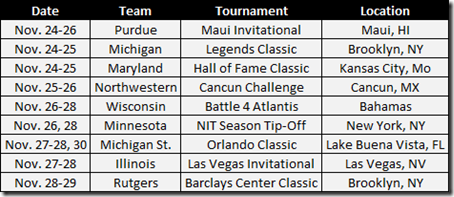
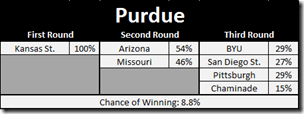
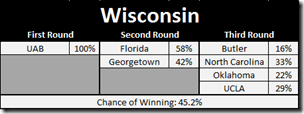










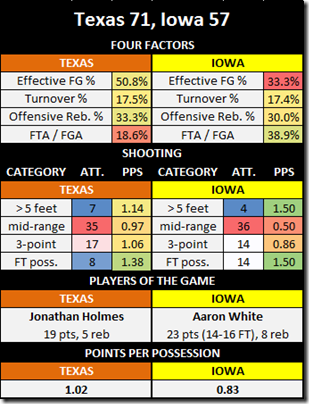
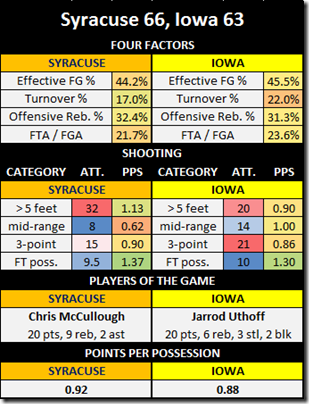


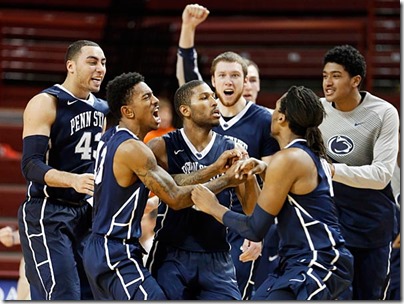
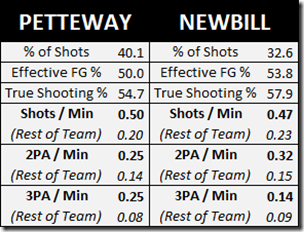

Comments